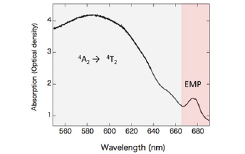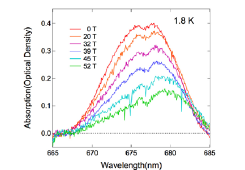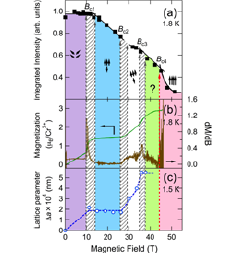Optical Access to Frustrated Spin Spinel HgCr2O4 in Pulsed Strong Magnetic Fields
Takeyama Group
HgCr2O4 belongs to a series of the chromium spinel oxides ACr2O4 (A = Mg, Zn, Cd, Hg), comprising a three-dimensional pyrochlore antiferromagnet, and shows typical characteristics of geometrical spin frustration. When subjected to strong external magnetic fields, successive magnetic phase transitions take place accompanied by discontinuous lattice distortions [1]. This material is known as the first three-dimensional spin frustration system that exhibits a remarkable half-magnetization plateau phase [2], which has been understood using a bilinear–biquadratic model that takes into account the spin–lattice interactions.

Fig. 1. Absorption spectra obtained at 4.2 K in a region of wavelengths where 4A2 → 4T2 and EMP transitions are observed in polycrystalline powder HgCr2O4 embedded in Stycast solid resin.

Fig. 2. Change of the EMP absorption spectra in magnetic fields.

Fig. 3. (a) Changes in an integrated intensity of the EMP absorption peak in magnetic fields. (b) Magnetization M and its derivative dM/dB as a function of magnetic field, measured at 1.8 K [2], and (c) Variation of the lattice parameter Δa plotted against magnetic field. The data (circle) are reproduced from Fig. 2. in ref. [1].
Upon decreasing atomic size going from Hg to Zn or Mg at the A cation site in the pyrochlore lattice, much intense magnetic fields are required to reveal all of the rich magnetic phases up to fully saturated magnetization, owing to the increased nearest-neighbor antiferromagnetic exchange interaction. Our group has explored an optical method to approach magnetic phases in extremely high magnetic fields and applied to CdCr2O4 [3], ZnCr2O4 [4], and MgCr2O4 [5]. A novel magnetic phase that is hidden in conventional magnetization data has been detected by the optical method, just prior to the fully polarized moment state. We have termed this as the last ordered phase (LOP). The LOP was concluded to be a phase corresponding to a magnetic “superfluid” state, inferred from an analogy to symmetry breaking of the quantum phases in 4He, whereas the detailed spin structure is not yet clarified. One of the plausible candidate is the spin “nematic” state. There needs, however, various experimental approach for verification. On the other hand, the magnetic-field strengths (B) at which the LOP is realized are extremely large and methods of measurement probes are quite restricted. The LOP in HgCr2O4 could be detected in magnetic fields around 40 T, much lower than those in CdCr2O4 and ZnCr2O4. However, in case of HgCr2O4, only powdered samples were available, that has been a hurdle for the optical approaches.
An exciton-magnon-phonon (EMP) absorption spectra were detected in a powder sample dispersed in Stycast 1266 transparent sold resin (Fig. 1), and the spectra were measured in magnetic fields up to 55 T (Fig. 2). The EMP absorption, reflecting a magnon density of states, showed the intensity variations corresponding to the point of successive phase transitions consistent with those of magnetization [2], lattice distortions [1], and electron magnetic resonance [6] measurements, where successive anomalies reported by other group. All these data are summarized in Fig. 3. This study has revealed that a fourth phase, termed LOP, also exists in HgCr2O4 and is related to the magnetic “superfluid” state that has also been observed in CdCr2O4 and ZnCr2O4 prior to the full-saturation phase. This study has revealed that the existence of the “superfluid” magnetic state, possibly of the spin “nematic” state is of universal among the chromium spinel magnetic frustrating oxides [7].
References
- [1] Y. Tanaka , Y. Narumi , N. Terada , K. Katsumata, H. Ueda, Urs Staub, K. Kindo, T. Fukui, T. Yamamoto, R. Kammuri, M. Hagiwara, A. Kikkawa, Y. Ueda, H. Toyozawa, T. Ishikawa, and H. Kitamura, J. Phys. Soc. Jpn. 76, 043708 (2007).
- [2] H. Ueda, H. Aruga Katori, H. Mitamura, T. Goto, and H. Takagi, Phys. Rev. Lett. 94, 047202 (2005).
- [3] A. Miyata, S. Takeyama, and H. Ueda, Phys. Rev. B 87, 214424 (2013).
- [4] A. Miyata, H. Ueda, Y. Ueda, H. Sawabe, and S. Takeyama, Phys. Rev. Lett. 107, 207203 (2011).
- [5] A. Miyata, H. Ueda, and S. Takeyama, J. Phys. Soc. Jpn. 83, 063702 (2014) .
- [6] S. Kimura, M. Hagiwara, T. Takeuchi, H. Yamaguchi, H. Ueda, Y. Ueda, and K. Kindo, Phys. Rev. B 83, 214401 (2011).
- [7] D. Nakamura, A. Miyata, Y. Aida, H. Ueda and S. Takeyama, J. Phys. Soc. Jpn. 83, 113703 (2014).
